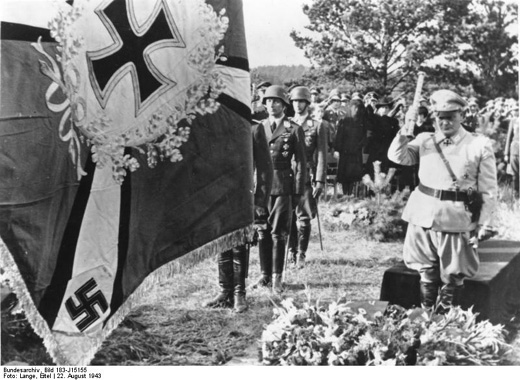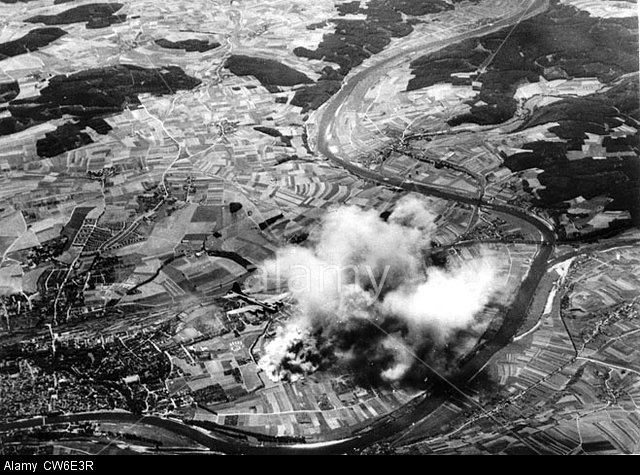Air Operations, CBI
CHINA- 4 23rd Fighter Group P-40 fighter-bombers attack Mangshih.
- 23 308th Heavy Bomb Group B-24s attack a Japanese Army barracks at Cau Lo in 3 waves.
Air Operations, East Indies
380th Heavy Bomb Group B-24s attack oil facilities at Balikpapan, Borneo.
[Air Operations, Europe
The Americans mount a large daylight raid on the ball-bearing manufacturing centers at Schweinfurt by 230 aircraft and Regensburg by 146 aircraft. 51 aircraft are lost, one-fifth of the attacking force. Such losses are insupportable.
|
|
Evening Ops:
- 596 aircraft are sent to hit Peenemünde, the German research on the Baltic coast where V2 rockets are being built and tested. In the total are 324 Lancasters, 218 Halifaxes and 54 Stirlings.
- The raid is carried out in moonlight to increase the chances of success. There are several novel features:- there is a Master Bomber controlling a full-scale Bomber Command raid for the first time; there are three aiming points - the scientists' and workers' living quarters, the rocket factory and the experimental station; the Pathfinders employ a special plan with crews designated as 'shifters', who attempt to move the marking from one part of the target to another as the raid progresses; crews of No 5 Group; bombing in the last wave of the attack, have practiced the 'time-and-distance' bombing method as an alternative method for their part in the raid.
- The Pathfinders find the target area without difficulty in the moonlight and the Master Bomber controls the raid successfully throughout. It is estimated that this raid set back the V2 experimental program by at least 2 months and reduces the scale of the eventual rocket attack. A mosquito diversionary raid to Berlin draws off most of the German night-fighters for the first 2 of the raid's 3 phases. Most of the casualties suffered by the attacking force occurs in the third phase when the night-fighers arrive in force. This is the first night on which the Germans use their new schräge Musik weapons; these are twin upward-firing cannons fitted in the cockpit of Me 110s. Two schräge Musik aircraft find the bomber stream flying home from Peenemünde and are believed to have shot down 6 of the bombers lost on the raid.
- 23 Lancasters, 15 Halifaxes and 2 Stirlings are lost.
- 8 Mosquitos carry out a successful diversionary raid on Berlin. This raid provides a good example of the effectiveness of window. The Mosquitos dropping window cause about 200 German fighters to operate over Berlin.
- 1 Mosquito is lost.
During the night 88 German bombers are sent to attack Lincoln. None find the target as bombs are scattered along the East Coast. 11 planes are lost.
US 8th AIR FORCEFRANCE:
- 29 386th Medium Bomb Group B-26s attack the Bryas Sud Airdrome at 1051 hours with about 35 tons of bombs.
- 2 B-26s are damaged; no crew casualties
- In the afternoon, 35 323rd Madium Bomb Group attack the Poix/Nord Airdrome.
- 20 B-26s are damaged; 1 crewman is wounded
- 180 Tunisian-based NASAF B-17s attack the Istres-le-Tube and the Salon-de-Provence Airdromes, dropping over 25,000 20-pound fragmentation bombs and claiming 94 enemy aircraft destroyed on the ground. 1 Luftwaffe plane is downed by an escort fighter, and bomber crews claim 23 enemy aircraft downed.
GERMANY:
- The VIII Bomber Command mounts an attack against ball-bearing-industry targets in and around Schweinfurt. Between 1148 and 1207 hours, 127 4th Heavy Bomb Wing B-17s attack aircraft factories at Regensburg with about 300 tons of bombs. Heavy resistance from Luftwaffe fighters and flak is encountered. The B-17s then fly to friendly bases in North Africa.
- 24 B-17s are lost, 50 damaged; 4 crewmen killed, 9 wounded, 200 missing
- In the second phase of the mission, 183 1st Heavy Bomb Wing B-17s attack the Schweinfurt ball-bearing plants with over 424 tons of bombs between 1459 and 1511 hours. Flak and Luftwaffe fighter opposition is extremely heavy. B-17 gunners claim 148 Luftwaffe fighters downed along with 18 probables, but actual losses are lower by several orders of magnitude.
- 36 B-17s are lost, 121 damage; 3 cresmen killed, 12 wounded, 352 missing
- P-47 escorts of the 4th, 56th, and 78th Fighter Groups down a total of 19 Luftwaffe fighters in a series of sharp battles over Germany, Belgium, and the Netherlands.
ITALY:
- About 100 NASAF medium bombers attack Battipaglia and Castrovillari, in the toe of Italy, and escorting P-38s strafe numerous targets of opportunity in the region.
- NATAF aircraft and IX Fighter Command P-40s attack shipping in the Straits of Messina and neighboring bodies of water.
- NATAF aircraft attack the rail junction at Lamezia and strafe and bomb Axis troops moving through the area.
Air Operations, New Guinea
- In anticipation of an Allied ground offensive against Lae, the 5th Air Force opens a campaign to neutralize the airfield at Wewak and satellite fields at Boram, But, and Dagua. Between 0300 hours and dawn, 36 90th Heavy Bomb Group B-24s and 12 43rd Heavy Bomb Group B-17s attack all 4 airfields with incendiary bombs and parachute fragmentaion clusters. After first light, 29 3rd Light Bomb Group B-25 strafers (of 32 sent), escorted by 85 P-38s (of 99 sent), mount a low-level attack against the airfields at Boram and Wewak, and 3 38th Medium Bomb Group B-25 level bombers (of 26 sent from Port Moresby) attack the airfield at Dagua with fragmentation bombs. 3 heavy bombers are lost.
- 3rd Light Bomb Group A-20s attack Japanese Army ground troops in the Salamaua area.
Air Operations, Pacific
The US 5th Air Force carries out a devastating series of raids on Japanese 4th Air Army air bases in the Wewak area of New Guinea. The attack shocks the Japanese, who believed that US aircraft were outside the combat radius for a raid on Wewak. However, US engineers covertly constructed a forward air base 60 miles west of Lae, putting Wewak only 400 miles away from USAAF aircraft of Lt-Gen George C. Kenney. The attack by 200 US aircraft results in three-quarters of the Japanese air base being rendered unusable and only 38 Japanese aircraft left operational.
[Air Operations, Solomons
- Fresh ground troops are landed on Vella Lavella despite Japanese Navy air attacks. After AirSols fighters depart the beachhead area at dusk, several D3A 'Val' dive bomberss attack shipping off Barakoma and fatally damage 1 LST. Also, the early-warning air radar facility at Barakoma is demolished by a direct hit.
- Japanese Navy artillery based on Baanga Island continues to disrupt flight operations at the Munda Point airfield on New Georgia.
Battle of the Atlantic
While escorting Convoy SL-135 Hudson 'O' of No 200 Squadron sights U-405 and attacks with four depth charges. Upon returning to the area a short time later a large oil slick was on the water.
| Class | Type VIIC |
| CO | Kapitänleutnant Karl-Franz Heine |
| Location | Atlantic, SW of Dakar |
| Cause | Air attack |
| Casualties | 49 |
| Survivors | None |
Germany, Home Front
Col-Gen Jeschonnek, the Luftwaffe Chief of Staff, commits suicide.
Göring at Hans Jeschonnek's Funeral |
 |
Italy, Politics
Gen Giuseppe Castellano is received by Lisbon by the British ambassador Sir Ronald Campbell, but talks cannot proceed unit the Allies send military spokesman to take part in them.
[Sicily
Gen Patton's troops enter Messina at 10:15a.m. a few hours before the British. The campaign in Sicily is over in just 39 days. One disappointment for the Allies is the extent of the evacuation the Germans and Italians have managed. It was called Operation LEHRGANG (TRAINING COURSE). They have shipped 40,000 German troops with 50 tanks, 100 guns and a large quantity of supplies as well as 62,000 Italians across the Messina Strait, mostly in small craft. An unprecedented flak 'umbrella' prevents Allied air forces from causing serious disruption during the 14-day operation. The Germans have lost about 10,000 men killed or captured plus many wounded. The British and Americans have suffered about 7,000 killed and 15,000 wounded. More than 100,000 Italians have been taken. Although the campaign has been a political success in as much as Mussolini has been brought down, the escape of so many Germans makes the campaign in Italy a daunting prospect. Critics have suggested that the Allies could have made more imaginative use of their sea power, not only around the island but its attacks on the Italian mainland. It has been suggested also that the Allies would have done better to follow up their success on Sicily with an immediate move to the Italian mainland. Although this is a plausible idea, it does not take account of the wider strategic debate between the British and Americans.
[Solomons
A small force of Japanese reinforcements is landed on Vella Lavella and there is a small inconclusive action between American destroyers and the Japanese transport force. In Baanga Island the Americans make little progress although their 2 infantry regiments receive support from dive-bombers and artillery.
[
